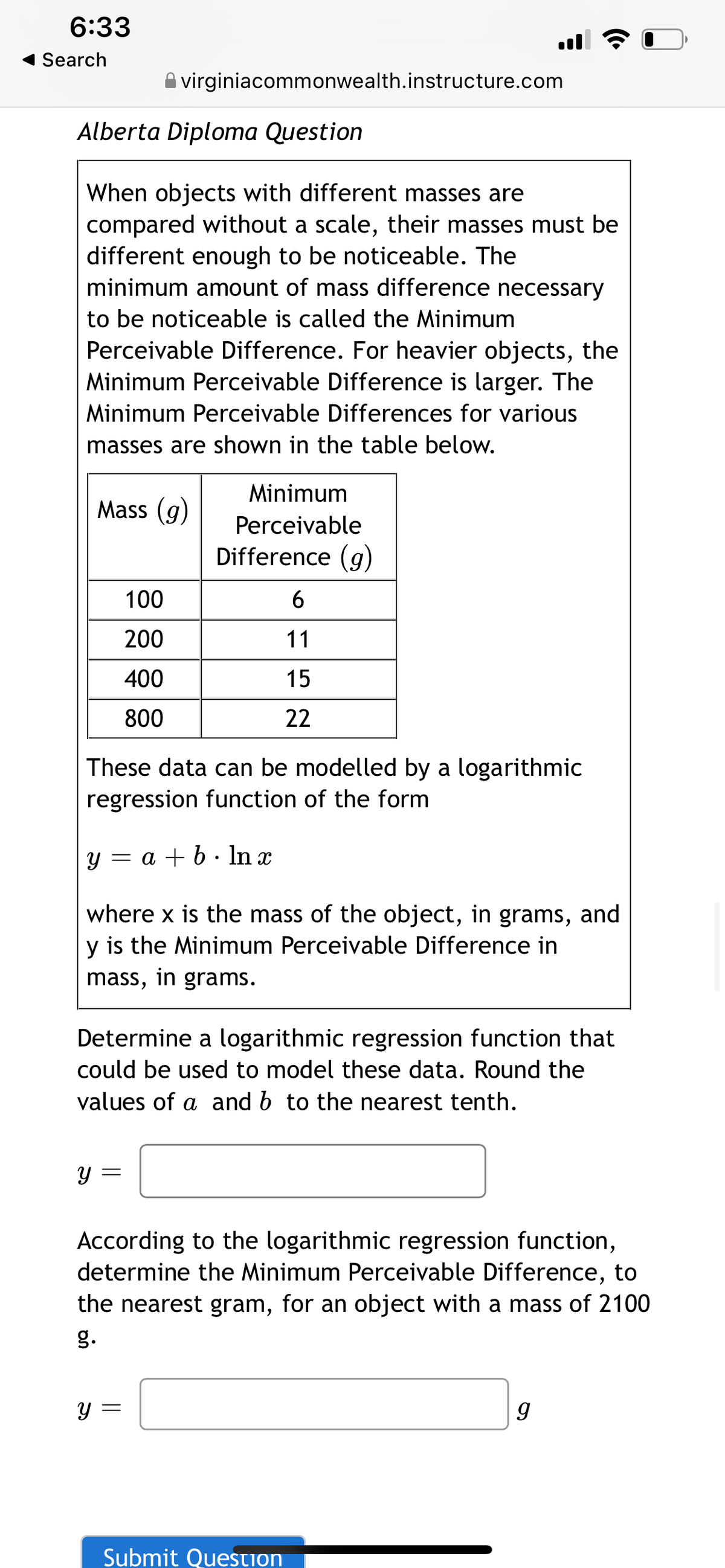Alberta Diploma Question When objects with different masses are compared without a scale, their masses must be different enough to be noticeable. The minimum amount of mass difference necessary to be noticeable is called the Minimum Perceivable Difference. For heavier objects, the Minimum Perceivable Difference is larger. The Minimum Perceivable Differences for various masses are shown in the table below. Minimum Mass (g) Perceivable Difference (g) 100 200 11 400 15 800 22 These data can be modelled by a logarithmic regression function of the form y = a + b · In x where x is the mass of the object, in grams, y is the Minimum Perceivable Difference in mass, in grams. and Determine a logarithmic regression function that could be used to model these data. Round the values of a and b to the nearest tenth. Y = According to the logarithmic regression function, determine the Minimum Perceivable Difference, to the nearest gram, for an object with a mass of 2100 g.
Alberta Diploma Question When objects with different masses are compared without a scale, their masses must be different enough to be noticeable. The minimum amount of mass difference necessary to be noticeable is called the Minimum Perceivable Difference. For heavier objects, the Minimum Perceivable Difference is larger. The Minimum Perceivable Differences for various masses are shown in the table below. Minimum Mass (g) Perceivable Difference (g) 100 200 11 400 15 800 22 These data can be modelled by a logarithmic regression function of the form y = a + b · In x where x is the mass of the object, in grams, y is the Minimum Perceivable Difference in mass, in grams. and Determine a logarithmic regression function that could be used to model these data. Round the values of a and b to the nearest tenth. Y = According to the logarithmic regression function, determine the Minimum Perceivable Difference, to the nearest gram, for an object with a mass of 2100 g.
Linear Algebra: A Modern Introduction
4th Edition
ISBN:9781285463247
Author:David Poole
Publisher:David Poole
Chapter7: Distance And Approximation
Section7.3: Least Squares Approximation
Problem 32EQ
Related questions
Question

Transcribed Image Text:6:33
1 Search
virginiacommonwealth.instructure.com
Alberta Diploma Question
When objects with different masses are
compared without a scale, their masses must be
different enough to be noticeable. The
minimum amount of mass difference necessary
to be noticeable is called the Minimum
Perceivable Difference. For heavier objects, the
Minimum Perceivable Difference is larger. The
Minimum Perceivable Differences for various
masses are shown in the table below.
Minimum
Mass (g)
Perceivable
Difference (g)
100
6
200
11
400
15
800
22
These data can be modelled by a logarithmic
regression function of the form
= a + b · ln x
where x is the mass of the object, in grams, and
y is the Minimum Perceivable Difference in
mass, in grams.
Determine a logarithmic regression function that
could be used to model these data. Round the
values of a and b to the nearest tenth.
%3D
According to the logarithmic regression function,
determine the Minimum Perceivable Difference, to
the nearest gram, for an object with a mass of 2100
g.
Submit Question
||
Expert Solution
This question has been solved!
Explore an expertly crafted, step-by-step solution for a thorough understanding of key concepts.
This is a popular solution!
Trending now
This is a popular solution!
Step by step
Solved in 2 steps

Recommended textbooks for you

Linear Algebra: A Modern Introduction
Algebra
ISBN:
9781285463247
Author:
David Poole
Publisher:
Cengage Learning

Algebra & Trigonometry with Analytic Geometry
Algebra
ISBN:
9781133382119
Author:
Swokowski
Publisher:
Cengage

Mathematics For Machine Technology
Advanced Math
ISBN:
9781337798310
Author:
Peterson, John.
Publisher:
Cengage Learning,

Linear Algebra: A Modern Introduction
Algebra
ISBN:
9781285463247
Author:
David Poole
Publisher:
Cengage Learning

Algebra & Trigonometry with Analytic Geometry
Algebra
ISBN:
9781133382119
Author:
Swokowski
Publisher:
Cengage

Mathematics For Machine Technology
Advanced Math
ISBN:
9781337798310
Author:
Peterson, John.
Publisher:
Cengage Learning,

Functions and Change: A Modeling Approach to Coll…
Algebra
ISBN:
9781337111348
Author:
Bruce Crauder, Benny Evans, Alan Noell
Publisher:
Cengage Learning